
You intend:
Interact with the map
Or
Skip to text
The island of Pico, is located in the central group of the Azores archipelago in the Atlantic Ocean.
The second largest island, owes its name to its majestic and imposing mountain that is the highest point in Portugal with 2351 meters of altitude.
Voted one of the seven natural wonders of Portugal, the island of Pico has a wide range of sites, landscapes and activities that you will not want to miss!
When booking a car, you can move around the island and visit all the tourist attractions and not only!
The Pico Island offers, in addition to the numerous activities, several points of natural, architectural, cultural and gastronomic interest that you cant miss on your holidays!
All over the island you can see the vine cultivation, particularly in the Wine Museum, Wineries and especially in Lajido of Santa Luzia and Lajido of Criação Velha, in the north and east respectively, which was in 2004 ranked as World Heritage by UNESCO.
Whaling is another major activity which is still a main attraction in the island, namely through the museums of whaling and of the whaling industry. It was once one of the main population livelihoods and has now been transformed into whale watching, a fantastic experience that you should try.
For those who like adventure, you can also go diving with whales and dolphins.
You can also visit the Cave of the Towers (Gruta das Torres), which is the largest lava tube in Portugal.
For nature lovers, the natural park of Pico Island is another interesting point where you can observe the different flora and fauna of the Azores and where you can also walk through several tracks and let yourself be fascinated by nature.
Besides all this youll have the opportunity to taste the delicious local cuisine, specially fish and seafood dishes, including the famous Fish Stew.
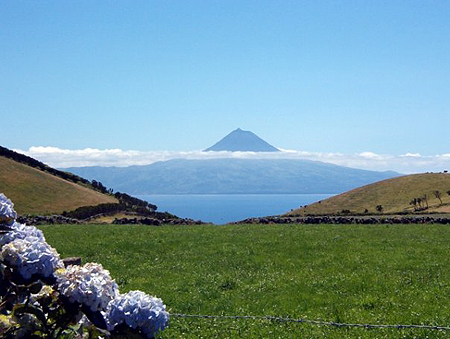
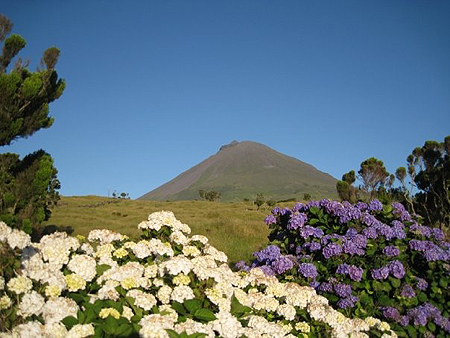
Despite not being a technical climbing, the ascent to Montanha do Pico (Pico 's Mountain) is of a medium/high degree of difficulty.
The trail has a total length of about 7600 m (3800 m from the base to the summit) and a unevenness of 1100 m, starting at the Mountain's House, at 1230 m of altitude, where all hikers do their ascent inscription, reaching the summit at 2351 m above sea level and ending with the return to Mountain's House.
During this journey you can watch the Furna-Abrigo, a volcanic cavity made by a figure of about 40 m depth and a gallery that served as shelter for walkers who ventured on the mountain. Throughout the climb is possible to observe natural habitats with rare endemic species, being the Pico's Mountain the only site in Azores that holds alpine and sub-alpine habitats that are subject to deposits of prolonged snow.
The various geological formations that can be observed along the climb are of great importance, such as pyroclastic deposits, Lava Toes, algares and lava tunnels, Hornitos, driblet-cones, lava plagioclase in rosettes and in lava gut. At 2050 m of altitude we can find a crater fossil and at the summit, a pit-crater, the lavic cone of Piquinho and an eruptive fissure.
As the hikers progress through the climb, the vegetation begins to be more rare, scattered and smaller, with only some species can survive the harsh climate on top of the mountain. It should be noted the Bremim Mountain (Silene uniflora ssp cratericola), an endemic sub-species that only exists in the crater of Pico's Mountain.
All this is complemented by a breathtaking landscape, where can be observed all the islands of the central group, if the weather conditions are favorable.
The Mountain's House is a point of mandatory stop in Pico's Mountain, being its main function the registration and monitoring of the mountain climbs.
Situated near the Cabeço das Cabras, the Mountain's House provides information on the geology, biology, history, climate and legal framework of the Nature Reserve of Pico's Mountain, or on bulletin boards or in movie format, which can be viewed in the auditorium of the house.
The control of the climbs is done through the mandatory registration of hikers or groups, either at the beginning or at the end of the climb, and through the GPS tracking system, which consists of delivering a GPS tracker which, in case of emergency, allows entering in contact with Mountain's House to be activated the rescue team. The system can also detect hikers who are lost, allowing them to be driven back to the official trail or to be rescued.
The Mountain's House is complemented by a bar with a panoramic views, where you can watch the entire west coast of Pico and Faial island.
Services
Registration, monitoring and support of the mountain climbs, Souvenir shop, Cafeteria, Ticket office, WC, WC for people with reduced mobility, Parking lot, ATM, Auditorium with film projection.
Opening Time
01 October to 30 April
Sat | Sun: 08.30am - 06.30pm
Closed: Mon to Fri
01 to 31 May | 16 to 30 September
Every day: 08.00am - 08.00pm
Open from 08.00am on Friday till 08.00pm on Sunday without interruption
01 June to 15 September
Every day: 24 hours
How to get there
The support house to Pico's Mountain, located at the foot of the mountain, is situated at 1100 m altitude. In any part of the island, head to the island's interior, following the direction of Madalena and you will find the access road properly marked.
GPS Coordinates
38º28'13,89'' N | 28º28'35,33'' W
![]() Para mais informações sobre este assunto, clique aqui.
Para mais informações sobre este assunto, clique aqui.
The Gruta das Torres, located in Criação Velha parish, had its origin in the lava flows of pahoehoe type, issued in the zone of Cabeço Bravo, and is the largest known lava tube in the Azores, with about 5150m in total length, with a maximum height of 15 m.
The interior is rich in geological formations, where we can highlight different types of lava stalactites and stalagmites, side benches, lava balls, striated walls and lava strung.
The Gruta das Torres is provided with a Visitors Center and provides a guided tour service in a natural environment, without using electricity or artificial bridges, except at the beginning of the route. Armed with a simple flashlight and helmet, visitors are invited to experience the natural environment of a cave, providing them a unique experience of contact with the subterranean reality of Pico island.
The Gruta das Torres is open to the public since 2005 as a Visitors Centre set up by the Regional Secretariat for the Environment and the Sea, whose architecture has already been awarded. The format of the visit is absolutely pioneer in Portugal since it promotes the preservation of the cavity, so little has been changed into the cave, so the visitor is guided with the necessary and appropriate equipment within a volcanic cavity unspoilt and preserved.
Since 2005, the Gruta das Torres has already been visited by more than 30 000 people and is an example of visitation, preservation and education for natural heritage of Pico Island and in the Azores Archipelago.
Services
Ticket Office, Souvenir Shop, ATM, Parking lot, Guided tour, WC, WC and Access for people with reduced mobility, Auditorium with film projection.
Opening Time
16 September to 14 June
Tue to Sat: 02.00pm - 05.30pm
Closed: Sun | Mon | Holidays1 | Mardi Gras | Easter Sunday | 24 and 31 December
Guided Tours: 02.30pm | 04.00pm
15 June to 15 September
Every day: 10.00am - 06.00pm
Guided tours: 10.30am | 12.00pm | 01.30pm | 03.00pm | 04.30pm
1Opens on the holidays of: Holy Friday; 25 April; 1 May; 10 June; from 02.00pm - 05.30pm, except if these days are Sundays or Mondays
Prices
Full Ticket: 7
Family Ticket (2 adults with children up to 17 years old): 13
Discounts:
Child (up to 12 years old): Free
Junior (13 to 17 years old): 3,50
Senior (> 65 years old): 3,50
Youth Card; Inter-jovem Card; Student Card; Partnership Cards: 5,60
Contacts
Address: Caminho da Gruta das Torres, Criação Velha, 9950 Madalena
E-mail: pnpico.grutadastorres@azores.gov.pt
Phone: (+ 351) 924 403 921
How to get there
The center is located in the Criação Velha parish, Madalena village, 10 minutes by car from the center of the village. Head towards the Criação Velha parish and find its signaling.
GPS Coordinates
38º29'39,51'' N | 28º30'08,63'' W
![]() Para mais informações sobre este assunto, clique aqui.
Para mais informações sobre este assunto, clique aqui.
The Landscape of the Pico Island Vineyard Culture Interpretation Centre is located in the heart of the core of Lajido de Santa Luzia, constituting a starting point for understanding the valuable cultural heritage classified as World Heritage Site by UNESCO in 2004.
The visitor has the opportunity to see the permanent exhibition and a film, and to walk in a traditional vine production, realizing the uniqueness of this landscape and the elements that compose it.
In the vicinity of the Environmental Centre, it is also possible to visit the interior of a warehouse and a traditional alembic still in operation, and go all the core of Lajido, and so understand how this is linked to the culture of the vine and fig tree.
This Centre is installed in an old building of sunny features, having suffered structural consolidation works and remodeling, whose architectural design is by the SAMI-Architects. It was inaugurated on June 29, 2010, having already been nominated for a national award for the specialty.
Services
Ticket Office, Souvenir Shop, WC, WC for people with reduced mobility, Guided Tour, Children's Play Area, Auditorium with film projection, Permanent exibithion, Interactive Kiosk, Tasting zone.
Opening Time
16 September to 14 June
Tue to Sat: 09.30am - 12.30pm
Closed: Sun | Mon | Holidays1 | Mardi Gras | Easter Sunday | 24 and 31 December
15 June to 15 September
Every day: 10.00am - 06.00pm
1Opens on the holidays of Holy Friday; 25 April; 1 May; 10 June; from 09.30am - 12.30pm, except if these days are Sundays or Mondays.
Prices
Visit the Centre: free entrance
Knowing Lajido's Heart (Guided Tour to the Museum Site and Lajido):
Full ticket: 5
Knowing Lajido's Heart - Family Ticket (2 adults with children up to 17 years old): 9
Trip to the Lajido's Scents (Guided Tour to the Museum Site and Lajido and Wine Tasting): 7
Scents and Flavours2:
- 2 wines: 3,50
- 4 wines: 6
- 6 wines: 9
Discounts:
Child (up to 12 years old): Free
Junior (13 to 17 years old): 2,5 (Knowing Lajido's Heart)
Senior (+65 years old): 2,5 (Knowing Lajido's Heart) | 3,5 (Trip to the Lajido's Scents)
Youth and Student Card Holders: 4 (Knowing Lajido's Heart) | 5,6 (Trip to the Lajido's Scents)
2The Wine tasting is not subject to discounts and is only for over 18 years old. During low season, only by reverse and for groups with a minimum of 12 people.
Contacts
Address: Lajido de Santa Luzia, 9940-108 São Roque do Pico
E-mail: pnpico.culturadavinha@azores.gov.pt
Phone: (+ 351) 292 207 375
How to get there
This Centre is located in the heart of Lajido de Santa Luzia, near the coast, Santa Luzia parish, São Roque do Pico council. It is located roughly 11 km from the villages of São Roque do Pico and Madalena. The access from Madalena can be done in two ways, the Regional Road and / or the road along the coast, then simply follow the road signs with the name "Lajido". While access from São Roque do Pico, is made by the Regional Road, following the signs with the indication "Lajido".
From the airport to the downtown is 5 minutes.
GPS Coordinates
38º33'24,66'' N | 28º25'40,15'' W
![]() Para mais informações sobre este assunto, clique aqui.
Para mais informações sobre este assunto, clique aqui.
The Moinho do Frade, located right in the area classified as World Heritage, in one of the most iconic - the Lajido de Santa Luzia. It is a windmill that given to their state of degradation has been rebuilt in 2003/2004. The work has been performed in order to obtain an accurate copy of the original mill and it is even equipped with the necessary means for its original function of grain milling.
Due to its privileged location, the Moinho do Frade is a great place for contemplation of what was a glorious work of our ancestors, a landscape made of lattice walls.
Prices
Free Visit.
Contacts
In the Natural Park of Pico, Lajido de Santa Luzia (+351 292 207 375).
How to get there
It lies at 5 km from Madalena center, and access is possible from this village, or elsewhere in the island you should follow the direction of Criação Velha parish, Lajido da Criação Velha. Here and, given his configuration, it is viewed quickly.
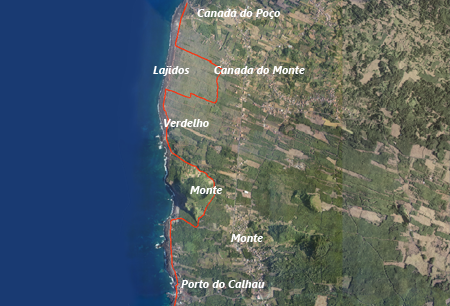
The trail starts at the tide pool of Porto do Calhau, district of Candelária. It was distinguished by BootsnAll magazine as one of the 8 most unique tracks in the world in 2010, thanks to the scenic and cultural diversity it provides. The trail is fully inserted in cultural landscape, classified by UNESCO as World Heritage, where the vast lush green of vineyards is striated by the contrasting rough black of stone walls. This trail is rich in elements associated with the culture of vine, such as "rola-pipas" (carved ramps for the transportation of barrels), "relheiras" (bare basalt tracks where the wheels of ox-carts loaded with produce ground out permanent ruts), shelter houses, cellars and tide wells. An old manor house, called Solar dos Salemas marks the end section of this trail, where you can rest at the sound of sea and seabirds while observing the islets of Madalena, remains of a submarine volcano, crown jewel of the region.
Porto do Calhau (38º4850,348N ; 28º5389,239O)
Extention: 8km
Level of difficulty: easy
Duration: 2h
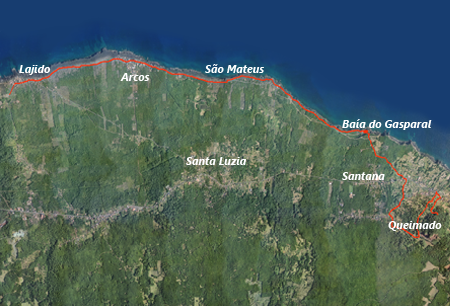
This trail begins on the whaling lookout, Sant'ana, district of Santo António. It crosses a rural location, follows the coast, in an area classified by UNESCO as World Heritage. You will cross the coastal villages of Santana, Cabrito, Arcos and Lajido, with their cellars, warehouses, chapels, stills, wells tide and a number of old manor houses. The trail is dominated by lava fields where various volcanic formations can be observed, such as pahoehoe lava and tumuli. It is also marked by an extensive « net » of stone walls called currais for the cultivation of vine (rectangular and quadrangular) and fig (semicircular). Reaching the end of the trail, do not miss the chance to the Landscape of the Pico Island Vineyard Culture Interpretation Centre in Lajido de Santa Luzia.
Vigia da Baleia (38º5451,880N ; 28º3647,120O)
Extention: 8,7km
Level of difficulty: easy
Duration: 2h30m
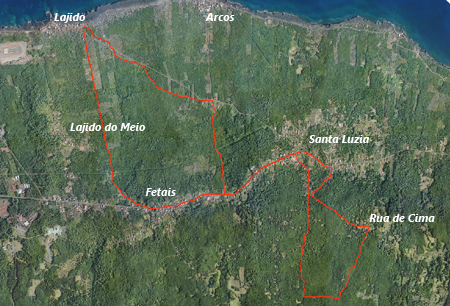
This trail begins in the parish of Santa Luzia, next to the Regional Road, continues down towards the sea through the Landscape of Pico Island Vineyard Culture, where you will discover centenarian paths once used by the inhabitants of this island. In some sections of these old paths, it is still possible to see the relheiras, carved in natural rough rock, with small stone slabs flanked by high walls of dry stone masonry. Further south, from the church of Santa Luzia, the trail becomes circular, entering a dirt road that leads to an old path flanked by stone walls and dense vegetation, bringing us back to the church.
Santa Luzia (38º5416,068N ; 28º4165,760O)
Extention: 10,5km
Level of difficulty: medium
Duration: 3h
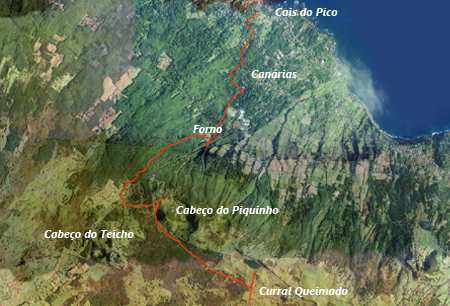
The trail starts in the central plateau of Pico, in Lagoa do Capitão and offers natural habitats of various species of endemic flora, many with special protection status: Platanthera micrantha, Daisy (Bellis azorica) and Sanicle (Sanicula azorica). This extremely interesting trail, not only offers a magnificent scenery but also the possibility to listen to the song or even spot bird species such as the Canary (Serinus canaria), Blackbird (Turdus merula azorensis), Common Chaffinch (Fringilla coelebs moreletti), Goldcrest (Regulus regulus), Blackcap (Sylvia atricapilla atlantias) and Grey Wagtail (Motacilla cinerea patriciae).
Lagoa do Capitão (38º4818,210N ; 28º3194,170O)
Extention: 9,2km
Level of difficulty: medium
Duration: 3h
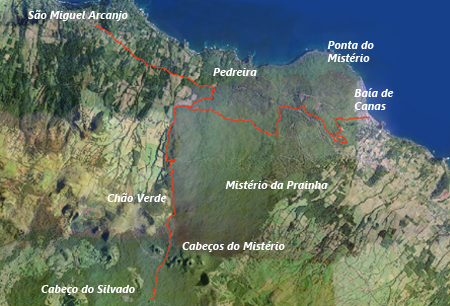
The trail starts at the central plateau and follows an old communication road once used by the inhabitants of the northern and southern coasts of the island. It crosses the Nature Reserve of Mistério da Prainha, ending at Baía de Canas and provides stunning natural landscapes, dominated by rare endemic habitats and species of flora and fauna that present a community interest, notably Euphorbia stygiana, Frangula azorica, Heather (Erica azorica), Azorean Blueberry (Vaccynium cylindraceum), Holly (Ilex azorica), Arceuthobium azoricum and Juniper (Juniperus brevifolia). The landscape is also strongly marked by typical structures of effusive volcanism. These lava flows were issued by Cabeços do Mistério during the historical eruption of 1562 - 64 (the longest historical eruption of the Azores).
Caminho das lagoas (38º4623,200N ; 28º2763,840O)
Extention: 12km
Level of difficulty: medium
Duration: 3h20m
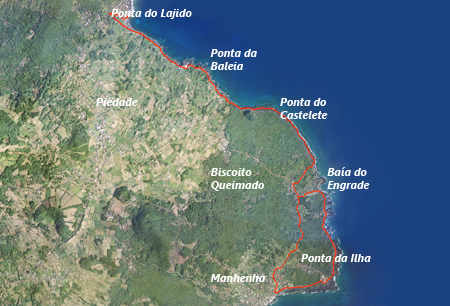
The trail starts at Porto do Calhau, parish of Piedade. It follows mostly old paths along the coast, once used by fishermen, and crosses the Protected Landscape of Pico Island Vineyard Culture, ending at the lighthouse, in Manhenha. A section of the trail is located in a nesting area for terns (Sterna hirunda and / Sterna dougallii), which is why, between May and July, an alternative path has been clearly marked. At the end of the trail, before reaching Baía da Manhenha, you will see the lighthouse of Ponta da Ilha, standing on one of the richest coastal habitats in regards to the diversity of endemic species, most with the protection status, notably Lotus azoricus and Myosotis maritima.
Porto do Calhau (38.4392166,-28.0561282)
Extention: 10km
Level of difficulty: difficult
Duration: 3h
Para mais informações sobre este assunto, clique aqui.